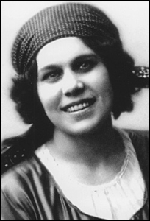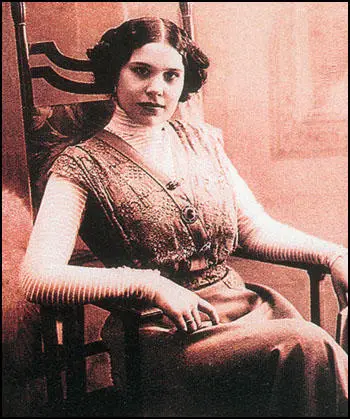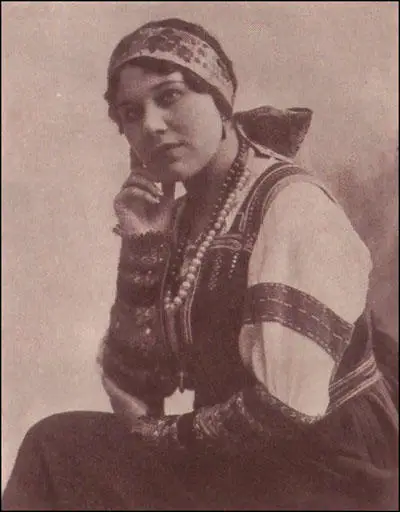Nadezhda Plevitskaya

Nadezhda Plevitskaya was born in the village of Vinnikovo near Kursk on 17th January 1884. She had eleven brothers and sisters but five of them died in childhood. Nadezhda loved to sing but her parents could not afford to pay for lessons. Her mother was devoutly religious and she was placed in the Trinity Nunnery. She had no desire to become a nun and ran away and joined a traveling circus.
Eventually she became a professional singer in Kiev. After her marriage to Edmund Plewicki, a Polish dancer, in 1903 she moved to Moscow, where she began singing in restaurants. She later recalled "Muscovites love me and I fell in love with the Muscovites."
In 1909 she was heard by the world famous tenor Leonid Sobinov. He was so impressed with her voice that he arranged for her to perform at the Chaliapin Art Theatre. Over the next few years she became established as one of Russia's most important singers. She also performed at court in front of Tsar Nicholas II and Empress Alexandra Feodorovna. Plevitskaya later recalled: "And the door opened, and I was with the Emperor. I bowed low and looked him straight in the face, and met the soft light shining eyes. Like a miracle happened, my fear was, I suddenly calmed down. He applauded warmly... I sang a lot. The Emperor was attentive and sensitive listener. Choice of songs was provided to me, and I sang what was to my liking. I sang a song about the guy-revolutionary unfortunate creature, who went to Siberia... He listened to me, and I saw the light in the eyes of the king's sad. The Emperor stepped up to me and just shook my hand." It is claimed that the Tsar was so moved by her singing that he "bowed his head and wept". As a result of this performance Alexandra was given a brooch with diamonds in the form of a beetle.
Feodor Chaliapin was also impressed with Nadezhda's singing. He was the most popular opera singer in Russia and was the star of the Bolshoi Theatre in Moscow. With his help she obtained a lucrative contract to appear in forty concerts throughout Russia. With this money she purchased a large plot of land and started building a mansion in Vinnikov.

One critic has claimed: "Plevitskaya possessed a rare musicality, lush and flexible, and a mezzo-soprano of wide range. Her repertoire included, alongside popular ditties of mediocre quality, superb examples of Russian peasant folk song from Kursk province as well as songs of city life that are still meaningful today. Her manner of performance showed great sincerity, rich intonation, expressive declamation, and an unusually subtle and deep feeling for the beauty of Russian speech."
During the First World War Nadezhda Plevitskaya appeared in several films. She also married again but he was killed on the Eastern Front in January 1915. After the Russian Revolution she became a Bolshevik and sang for the soldiers of the Red Army. In 1919 she was captured by Lieutenant-General Nikolai Skoblin, an officer of the White Army. Skoblin had a reputation for killing his prisoners but Plevitskaya's life was spared. Skoblin fell in love with Plevitskaya and despite their different political beliefs they married after the defeat of the anti-Bolshevist forces in the Russian Civil War.
The couple moved to Paris and Skoblin joined the Russian All-Military Union (ROVS). The organization attempted to start a national anti-communist uprising in Russia. Skoblin became the organization's intelligence chief. Plevitskaya made concert tours throughout Europe and on her visit to the United States she was accompanied by Sergei Rachmaninoff. However, she retained her belief in communism and in 1925 she and her husband, were recruited as a spy by Mikhail Shpiegelglass, a senior figure in the NKVD.

In December 1936, Nikolai Yezhov established a new section of the NKVD named the Administration of Special Tasks (AST). It contained about 300 of his own trusted men from the Central Committee of the Communist Party. Yezhov's intention was complete control of the NKVD by using men who could be expected to carry out sensitive assignments without any reservations. The new AST operatives would have no allegiance to any members of the old NKVD and would therefore have no reason not to carry out an assignment against any of one of them. Within the administration of the ADT, a clandestine unit called the Mobile Group. Its first victim was Ignaz Reiss who sent a letter to the Soviet Embassy in Paris explaining his decision to break with the Soviet Union because he no longer supported the views of Stalin's counter-revolution and wanted to return to the freedom and teachings of Lenin. Reiss was murdered in a village near Lausanne, Switzerland.
Yezhov wanted to demonstrate the Mobile Group capabilities by kidnapping General Yevgeny Miller, the chairman of the Russian All-Military Union. As Edward P. Gazur, the author of Alexander Orlov: The FBI's KGB General (2001): "Yezhov sent for Shpiegelglass, who had just returned from Switzerland after successfully arranging the assassination of KGB defector Ignaz Reiss, and asked if Shpiegelglass's Mobile Groups could handle the assignment. In the past, such assignments were handled by foreign nationals, who were members of the Communist Party of their country and associated with the Comintern; the Soviet Government could then deny any responsibility. Shpiegelglass acknowledged that the task could be done but that it would take at least three months of planning because of the strict personal environment surrounding Miller and because the vigilant French police made such an operation fraught with danger. Shpiegelglass suggested several possible scenarios for the kidnapping, but in the end Yezhov wanted immediate action. He proposed that Miller be lured under a suitable pretext to a house on the outskirts of Paris, where he would be drugged and then taken to a Soviet vessel in one of the French ports for delivery to the Soviet Union."
Mikhail Shpiegelglass, the head of the Mobile Group, met Nikolai Skoblin and it was decided to lure Miller into a trap. Skoblin was the ROVS intelligence chief and he told Miller that he arranged a meeting with two German army officers based in the German Embassy who were willing to pay for any information they had on the Soviet Union. On 22nd September, 1937, Miller got in Skoblin's car and they drove to a villa which the NKVD had rented. The two German officers were in reality, Shpiegelglass and one of his agents named Valeri Kislov. Miller was over-powered and injected with a sedative. Miller was placed in a large wooden container with numerous air holes. It was taken to Le Havre and placed on the Soviet cargo ship, Marya Ulyanova. That night it took the route north of Denmark to Leningrad.
During the investigation of General Miller's disappearance, the French police found a letter indicating that the missing man had a rendezvous with Skoblin. The police arrested Nadezhda Plevitskaya but Skoblin managed to escape and was given sanctuary in the Soviet Embassy in Paris. In November he was smuggled out of the embassy and put on a Soviet vessel bound for Leningrad. The NKVD agent, Alexander Orlov claims in his autobiography, The March of Time Reminiscences ( 2004) that Skoblin was killed before he reached the Soviet Union.
According to Gary Kern, the author of A Death in Washington: Walter G. Krivitsky and the Stalin Terror (2004): "Plevitskaya... pleaded that her husband had been kidnapped as well, but police found false passports, secret codes and other materials in their villa in Ozoir-la-Ferriere implicating the Skoblin couple as NKVD agents." Plevitskaya was brought to trial on charges of being an accessory to the crime. She pleaded her innocence but at the end of the trial that lasted four days, she was found guilty and sentenced to twenty years' hard labour. It is claimed by MI6 that NKVD agent, Walter Krivitsky, provided testimony that helped convict her. It has also been suggested that while she was in prison she confessed to a Russian priest that her husband had been a participant in the kidnapping of General Yevgeny Miller.
Nadezhda Plevitskaya died of a heart attack at Rennes Prison on 1st October 1940.
Primary Sources
(1) Edward P. Gazur, Alexander Orlov: The FBI's KGB General (2001)
Yezhov sent for Shpiegelglass, who had just returned from Switzerland after successfully arranging the assassination of KGB defector Ignaz Reiss, and asked if Shpiegelglass's Mobile Groups could handle the assignment. In the past, such assignments were handled by foreign nationals, who were members of the Communist Party of their country and associated with the Comintern; the Soviet Government could then deny any responsibility. Shpiegelglass acknowledged that the task could be done but that it would take at least three months of planning because of the strict personal environment surrounding Miller and because the vigilant French police made such an operation fraught with danger. Shpiegelglass suggested several possible scenarios for the kidnapping, but in the end Yezhov wanted immediate action. He proposed that Miller be lured under a suitable pretext to a house on the outskirts of Paris, where he would be drugged and then taken to a Soviet vessel in one of the French ports for delivery to the Soviet Union.
Shpiegelglass acceded to Yezhov's demand that immediate action be taken and proceeded to Paris, where he contacted General Nikolai Skoblin, the KGB's informant in the ROVS. Skoblin had commanded the famed Kornilov Division during the Civil War and had earned the distinction of being a ruthless but brave leader. His division had won many battles against the Red Army and was dreaded by the enemy because of its reputation for hanging or shooting captured Communists on the spot. In 1921, Skoblin had married the well-known Russian folk singer Nadezhda Plevitskaya. Soon after, they moved to Paris, where the General became one of the directors of the ROVS. It was in Paris in the late 1920s that Skoblin had been recruited by Shpiegelglass, with the help of Nadezhda, into the ranks of KGB informants. With Skoblin now in place, the KGB was able to know every move of the ROVS.
Shpiegelglass met Skoblin and a plan was soon conceived to lure Miller into a trap. Miller was to be told that two officers of the German General Staff attached to the German Embassy in Paris were interested in establishing communication with the ROVS as a means of securing information on the Soviets through the ROVS's intelligence-gathering apparatus. The Germans were prepared to pay for the information, which would appeal to the financially strapped ROVS and at the same time further its cause against the Soviets. Miller would be told that Berlin had authorised the contact with him and that it should be carried out in great secrecy so that the French Government did not learn of the liaison.
With a suitable plan now in hand, Shpiegelglass arranged to rent a villa in the environs of Paris, where Miller's meeting with the two Germans was to take place. Skoblin made his preliminary approach to Miller and found the General receptive to the idea of meeting the Germans. He also gave his word that he would tell no one. Skoblin left with the notion that he would make the final arrangements with the Germans. In the meantime, Shpiegelglass was in contact with Yezhov, who made arrangements for the Soviet merchant marine vessel S/S Maria Ulyanova, so named in honour of Lenin's sister, to make for the port of Le Havre, where it would be in position to take on the unsuspecting and unwilling passenger. The date of the operation would coincide with the arrival of the Soviet vessel at Le Havre. All the pieces were now falling into place.
(2) Richard Deacon, A History of the Russian Secret Service (1972)
The technique of "The Trust" had been re-created to combat the Trotskyites in particular, but Stalin's enemies in general. White Russians were again used to spy on both anti-Bolshevik and Trotskyite agents and at a given order to kidnap them or kill them. Sometimes kidnapping proved more effective, especially when it was a case of obtaining information. There was the case of General Eugene Miller, former chief of staff of the Czarist Fifth Army, who had gone to live in Paris. He was chairman of the Union of Russian ex-Combatants, an anti-Bolshevik White Russian organisation that had been founded by the exiled Grand Duke Nicholas. General Miller had been advised by the Union's secretary, Lieutenant-General Skoblin, that the best means of ousting the Soviet regime was to back Hitler and encourage him to wage a "liberating" war against Russia. At Skoblin's behest Miller agreed to meet two German secret agents to discuss plans. On 22 September 1937 General Miller set out to meet the Germans at a cafe on the outskirts of Paris. He was never seen again.
For a long time the Soviet Intelligence had marked down the Union of Russian Ex-Combatants as a dangerous group. It was perhaps one of the strongest remaining White Russian organisations with a membership approaching 80,000. Seven years earlier the Russians, disguising themselves as French gendarmes, had kidnapped the former head of the Union, General Kutyepoff. No trace of him had ever been found.
It was the same with General Miller. Inquiries by the French police, prompted by strong representations from the Union, revealed that Miller had gone to Le Havre. There the trail ended, but coincidentally a Soviet cargo ship, Marya Ulyanova, left Havre the night he arrived there.
Vast sums were spent by the Soviet Secret Service in carrying out these kidnappings and killings. The organising of the quest for Ignace Reiss and his murder, it has been estimated, cost not less than £20,000, while Innostranny Otdyel (the dreaded Executive Branch for Terror and Diversion) spent hundreds of thousands of pounds on similar killings and kidnappings during the 'thirties, many of them carried out in distant lands.
Almost always there is the sinister figure of a "White" Russian among the men controlled by the Innostranny Otdyel. In the case of General Miller it turned out to be Lieutenant-General Skoblin, who had posed as a right-wing reactionary, sympathetic to Hitler and anxious for a "liberating" war against Russia. The two "Germans" who Skoblin had arranged should meet Miller were Soviet agents as indeed was Skoblin himself. He denied any knowledge of a plot and indignantly defended himself before a committee meeting of the Union, but shortly afterwards he disappeared from Paris and later was heard to be in Moscow. The interesting fact emerges from this story that Skoblin had been a friend of Sidney Reilly and an active Soviet agent from a date shortly after Reilly was arrested in Russia.
